Facial Gymnastics
Given the rise of the physical culture movement in the nineteenth century it was inevitable that its principles would be used to sculpt the face.
We buy dumb bells, Indian clubs, chest weights and medicine balls galore to strengthen and improve every known and unknown muscle in the body, from our necks downward, but what about the muscles of our face?
They, too, can be remedied or improved, and are quite as susceptible of development as many muscles of the body, so Prof. Dowd, physical culture instructor, will tell you.
Hundreds of faces are round and plump, yet not beautiful, or even pretty. They are all flesh and no muscle. There must be just enough plumpness from the development of muscular tissue to bring out nature’s beautiful curves, obviate either flabbiness or vulgar fat.
Now, there are a few exercises, which, if practiced fifteen minutes daily, or even five minutes, will do more to improve one’s looks than all the lotions in the world. Indeed, you may throw lotions and rouge and powder de riz to the winds provided you go to work systematically.(Mend your face, The Morning Times, 1896)
Along with the facial exercises went a way of life. Physical culturists were critical of ‘unhealthy urban life styles’ which included the use of powder and paint. Health rather than cosmetics was seen as the basis of good looks.
The smoke in our cities, the lack of ventilation in our homes and in general our present mode of living has resulted in these conditions. Yet we see on all hands beautiful, attractive women. For instance, Mme. Lillian Russell, whom the American theatergoers much admire because of her beauty, she has passed middle age and still displays no wrinkles. Her charms are as attractive as over.
“Ah, I tell you her secret and that of many other women not only in France, but in all civilized countries. The women who remain beautiful are the ones who exercise their facial muscles”.(Make an ugly face and be beautiful, The Standard, 1914)
As well as improving the contours of faces that were “all flesh and no muscle”, exercises were touted as a cure for other beauty problems such as pimples, excessive paleness, thin lips and wrinkles.
Never before as in the present generation has the value of exercise been clearly understood. It is quite the exception, nowadays, to meet a woman overburdened in the matter of flesh, or suffering from any of those aliments resulting from a sedentary life. As with the body so with the face. By exercising the muscles scientifically, they can retain all the elasticity of youth long after middle age has been reached. Exercise is the true secret of beauty, in the opinion of Madame Elizabeth Eve, who is prepared to back her words by actual proof of her own experiences. This clever specialist has for years now been practising what she preaches; her system of facial exercises has such far reaching results that it can keep the traces of Father Time completely at bay. Wrinkles, saggings, crowsfeet, and all the other evidences of age make no impression upon the face that is regularly exercised, and Elizabeth Eve guarantees, too, that many other unsightly defects will disappear by her system
(From 1920 advertorial for Elizabeth Eve).
Wrinkles
According to physical culturists, wrinkles were the result of droopy or flabby muscles. The only way to restore muscles that had lost their strength and vitality was through exercise. Facial exercises could firm and tighten flesh that had previously sagged and in this way wrinkled skin could be smoothed. Actors and actresses were sometimes used as a case in point. Their good looks were credited to strong facial muscles developed through frequent facial expression on the stage.
Development
Making faces to make yourself beautiful soon developed a number of adherents; prominent exponents included Lillian Russell and Annette Kellerman.
The contour of the face and the general appearance can be greatly improved by special exercises intended to develop those muscles.
Hollows in the cheeks can be filled in and the wasted, drawn look we see in so many faces replaced by a healthier, rounder contour. A face that is too stout can be reduced to some extent by these exercises and in some cases the flesh of the face can be made firm and healthy.(Annette Kellerman, El Paso Herald, 1912)
Early routines were relatively straight forward, consisting of a few simple exercises. However, between the wars, when physical culture reached its peak, more complex systems were developed and publicised. A good example of this is Elinor Gyln’s ‘The Wrinkle Book’ published in 1927.
The Wrinkle Book
The English novelist Elinor Glyn was known for her racy books and for coining the word ‘It’ as a euphemism for sex appeal. She was living in Hollywood at the time, a place where age and looks meant everything, and this may have been the prompt for the departure from her erotic fiction. Her book contained a detailed series of facial exercises that she claimed would help maintain youth and beauty.
For age and die we must all of us in time, but just as we fight the deterioration in other parts of our muscular bodies by sports, games and exercises, so we must fight the deterioration in the muscular tissues of our faces by a definite system of face muscle exercises based on a knowledge of the muscles that exist in the head, face and throat.
(Glyn, 1927, p. 35)
Two other benefits of facial exercises were alluded to in Glyn’s book. The first is improved circulation. Poor circulation resulted in ‘starved tissues’ and/or the ‘build up of toxins’, both regarded as major causes of ageing. When the facial muscles were exercised, blood containing ‘nourishment and glandular secretions’ was ‘drawn into tissues’ and ‘toxins were flushed out’, ‘old tissue was removed and new tissue was grown in its place’.
[T]he action of a muscle drawing in blood to itself … [is] very important to the effect of my exercises for keeping youth and beauty in the face. The reason for this is fairly obvious, I think. The blood is the life, in it are contained all the gland secretions and nourishment of the body which are necessary for its upkeep and well being.
Therefore if you draw blood to the flesh of any given part you nourish and renew it.(Glyn, 1927, p. 48)
The second benefit promised was improved ‘vitality’. This is a more nebulous area, part mind over matter, part the tapping of invisible forces.
Mind rules the body, and if, with the practice of these exercises, the thought is held that you are drawing to yourself the life force, you will actually draw it.
(Glyn, 1927, p. 9)
Beauty culture
Early beauty culturist’s ideas on the causes of wrinkles differed from, but had some overlap with, those put forward by the advocates of facial exercises. According to beauty culturists, wrinkles were caused by ‘tissue loss’, ‘sluggish circulation’ and/or ‘sagging muscles’. They advocated the use of creams and lotions – most commonly skin foods and astringents – to prevent or reduce these conditions, combined with manual therapies such as massage, strapping or patting. For beauty culturists, physical work was not enough; the creams and lotions were needed as well.
See also: Skin Foods, Skin Tonics, Astringents and Toners, Patters and Straps, Bandages and Tapes
Few beauty culturists heavily promoted the use of facial exercises as there was more money in selling cosmetic treatments. There are a few examples to the contrary, one being Rose Laird.
See also: Rose Laird
For their part, promoters of facial exercises were not above criticising beauty culture and their use of facial massage and massage creams.
To attain this desired mobility has been the object of innumerable systems and processes of beauty culture, all more or less silly and useless, and some positively harmful and to be avoided. Among the latter class, I may designate the much abused massage treatment.
The original principle of massage is an excellent one, but it was never intended to be applied to the muscles of the face. The virtue of massage begins and ends within very definite and exceedingly narrow limitations. It is a treatment which properly should be applied only to the invalid or convalescent patient, and then only as a stimulus toward the restoration of the normal muscular action of the body. To the face it should never be applied. If massage has any effect whatever upon the facial muscles it is only to make them coarse and heavy, or, in extreme cases, of sensual appearance. The fashionable superstition that a masseuse is able to ‘work’ out wrinkles by certain esoteric manipulations has no basis of fact to sustain it, either in science or in experience. The surest and best method to keep away wrinkles and all other signs of approaching age Is the possession of a keen interest in life, combined with a fair proportion of natural joy and natural sorrow!
The next best way is to make faces, just ugly faces—such as known in the school-room parlance as ‘snoots’.(Making faces to preserve beauty, The San Francisco Sunday Call, 1906)
Massage creams I consider unnecessary. I would prefer that women use plain water in treating the face. It stimulates the circulation and brings a natural rosy complexion that all the facial and massage creams in the world would not give.
(Standard Magazine, 1914)
Benefits of facial exercises
As a quick search of the internet will reveal, numerous proponents of facial exercise still exist today. The rationale for doing them has not changed much in the last 100 years, except that now they are also offered as an alternative to the plastic surgery or botox injections.
Given that a loss of muscle tone is not involved in the formation of wrinkles and that most of the lines on the face are caused by repeated facial expressions or sun damage, it is easy to see why many regard facial exercises as a waste of time. However, there is one area that most commentators do not mention, facial relaxation.
Some wrinkles are formed by repeated squinting or frowning over long periods of time. Relaxing the facial muscles of the face can help avoid these lines and ‘soften the contours’ of the face. A busy lifestyle, and the stress that goes with it, often has us walking around in a state of perpetual scowl, creating wrinkles between the eyebrows and around the eyes and mouth. Relaxing the facial muscles can smooth out many of these self-inflicted lines and prevent them from becoming permanent.
This idea was well known in the past but was usually tied to a moral agenda and a correct mental attitude.
The use of facial massage and good cold cream or skin food will be found generally beneficial, but the most Important factor in all beauty as In health is the mental attitude. If you would be beautiful avoid all thoughts of evil, all unkindliness, all malice, all worry end dislike; learn a broad tolerance of sin and weakness and a general love for all mankind. Realize that no one can injure you but yourself. Take this mental attitude and try to maintain it at all times. You may not wholly succeed, but you will not wholly fall, and then, as day after day you make the same effort to live upon a higher plane your face will relax and its contour soften.
(Lillian Russell, Washington Herald, 1911)
Unfortunately, it is difficult to get people to identify when they are frowning or grimacing. An old yoga trick is to first tighten and then relax muscles so that you can feel the difference. So, a brief set facial exercises during a busy day might help relax the muscles of the face. The key point here is that the facial contortions do not have to be extensive, 5-10 seconds will do, followed by closed eyes and some deep breathing with the mind focused on relaxing the muscles of the face. After a time, as you come to recognise the tension, you can even stop the facial gymnastics.
Updated: 13th September 2019
Sources
Fraser, E. (1991) Eva Fraser’s facial workout. London: Penguin.
Glyn, E. (1927). The wrinkle book or how to keep looking young. London: Duckworth.
Krane, J. (n.d.). How to stroke wrinkles right out of your face! Instant Improvement Inc.
Verni, M. (1946). Modern beauty culture (2nd ed.). London: New Era Publishing.
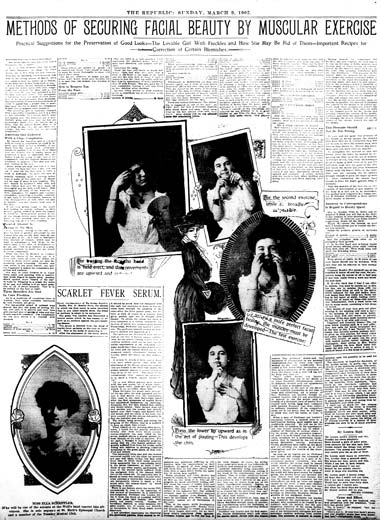
1902 Large newspaper story on the benefits of facial exercises.

1906 Images from a newspaper article titled ‘Making faces to preserve beauty’.
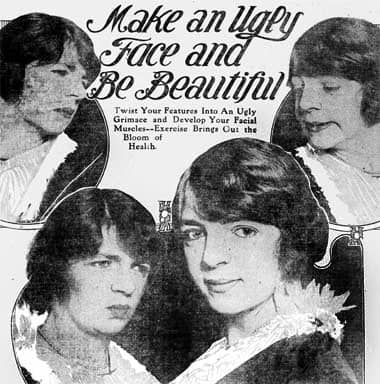
1914 Images from a newspaper article titled ‘Make an ugly face and be beautiful’.

The English novelist and Hollywood scriptwriter Elinor Glyn [1864-1943], author of ‘The Wrinkle Book’. Her ‘wrinkle free’ skin was much admired in England and the United States but was more likely to be the result of fortunate genetics and overcast English weather than facial exercises.

1916 Kathryn Murray Facial Exercises.
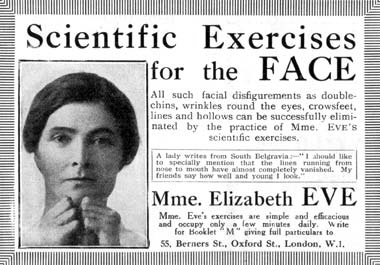
1919 Mme. Elizabeth Eve. Scientific exercises for the face.
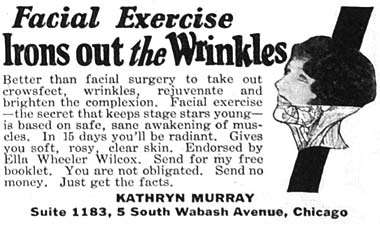
1927 Kathryn Murray Facial Exercises.
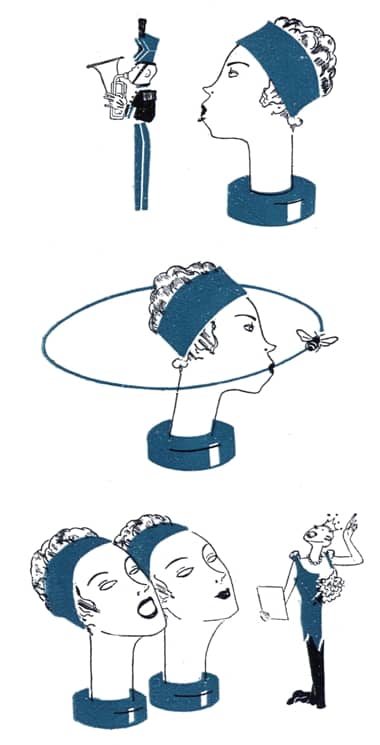
1938 Rose Laird [c.1877-1966] facial exercises: ‘The Huff and Puff’. ‘The Bee Chaser’ and ‘The Prima Donna’.
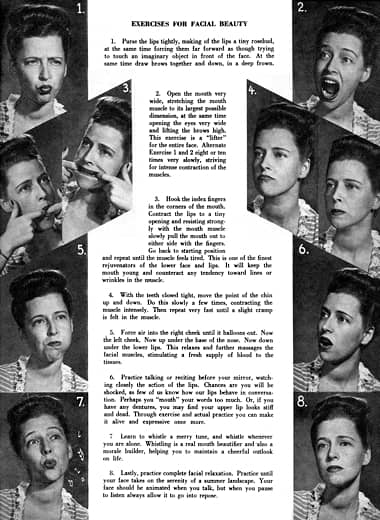
1945 Exercises for Facial Beauty.
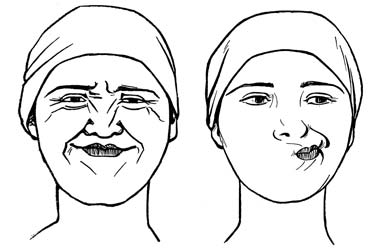
1946 Some Verni facial exercises.

1956 Facial exercises combined with triangular tape that was supposed to reduce the wrinkles between the eyebrows.

1975 Exercises to firm the neck and face.
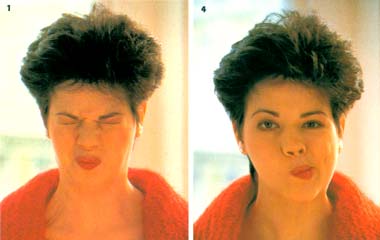
1982 Some Vogue facial exercises. When compared to those in Verni (above) not much has changed in 40 years
